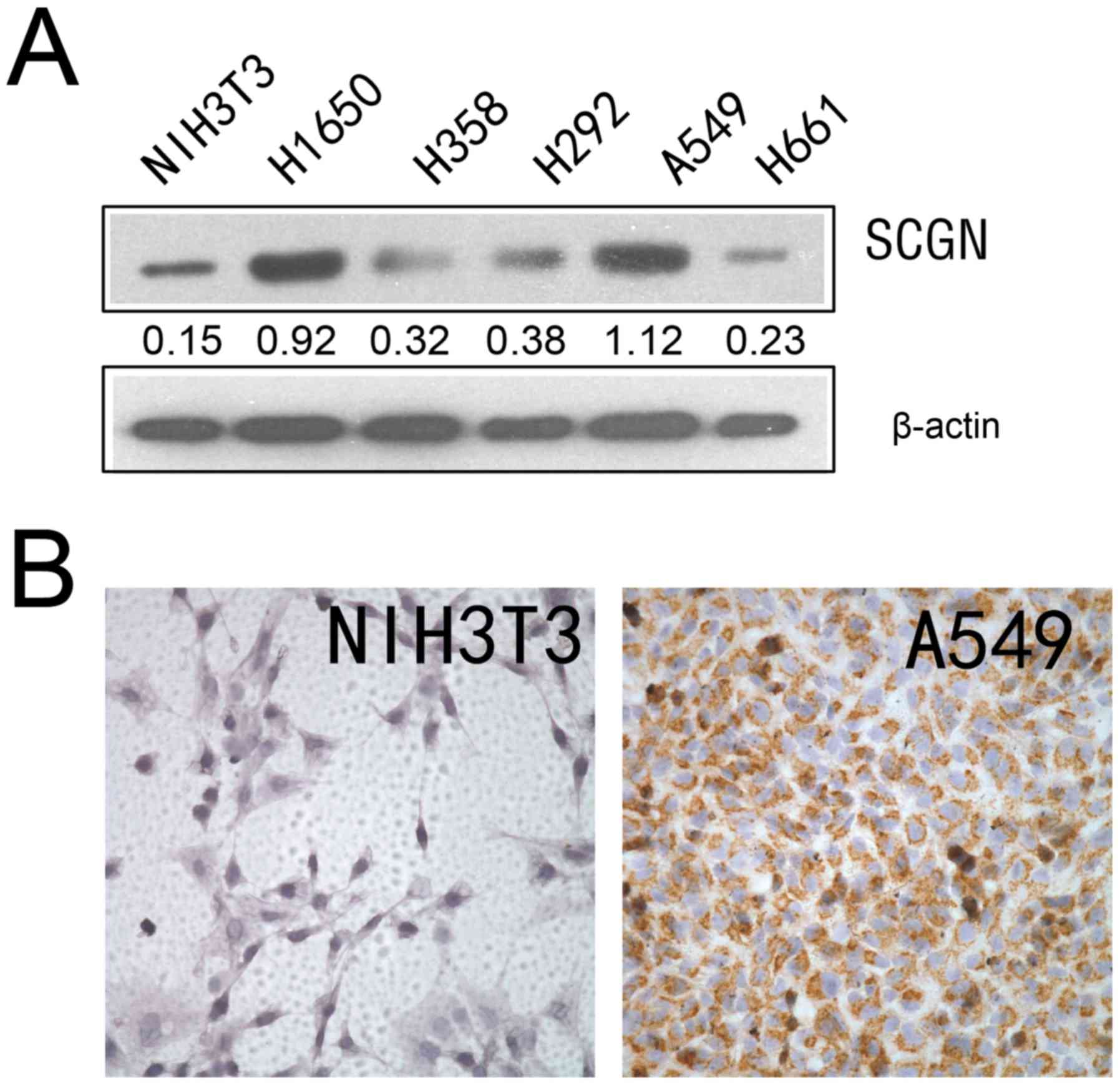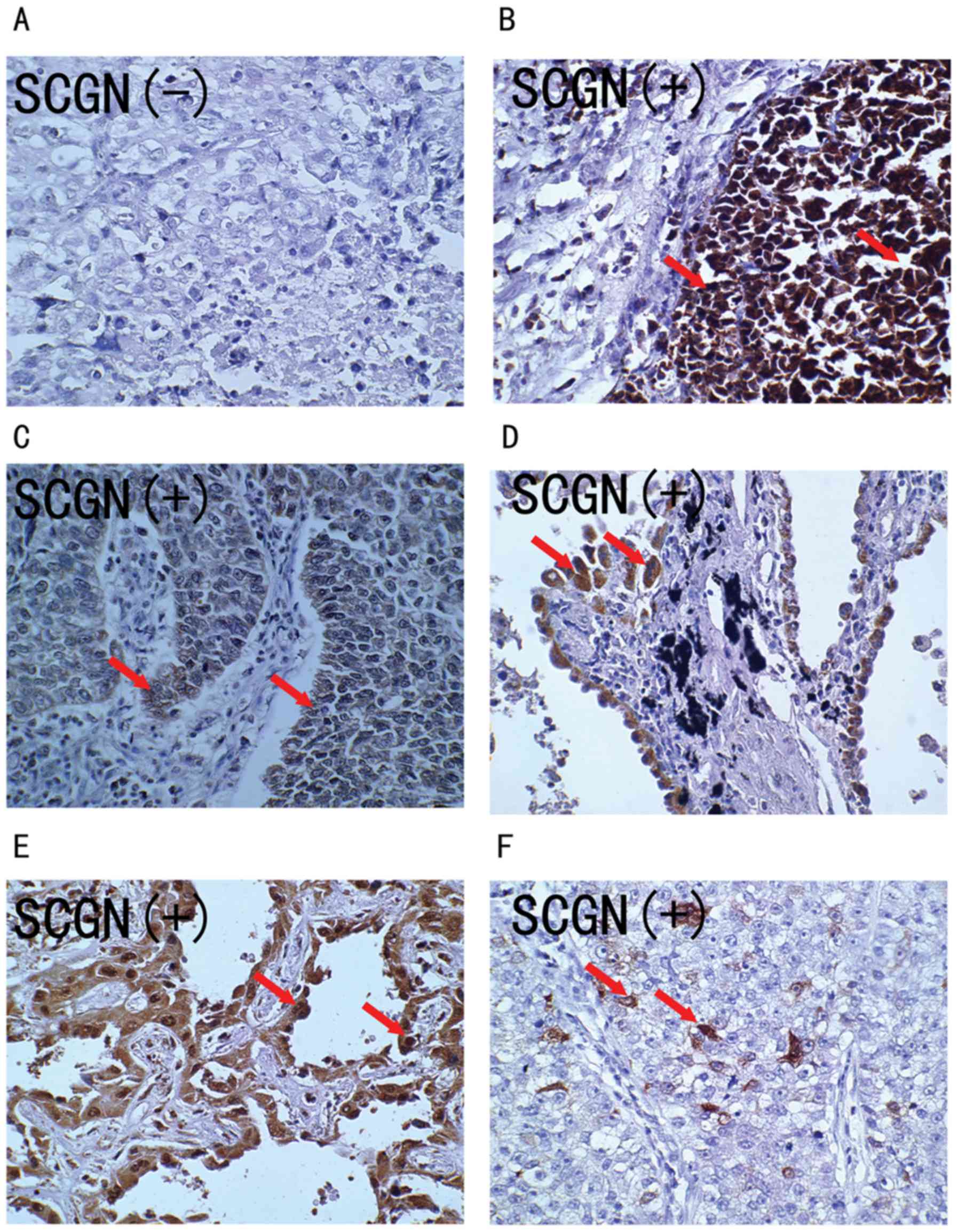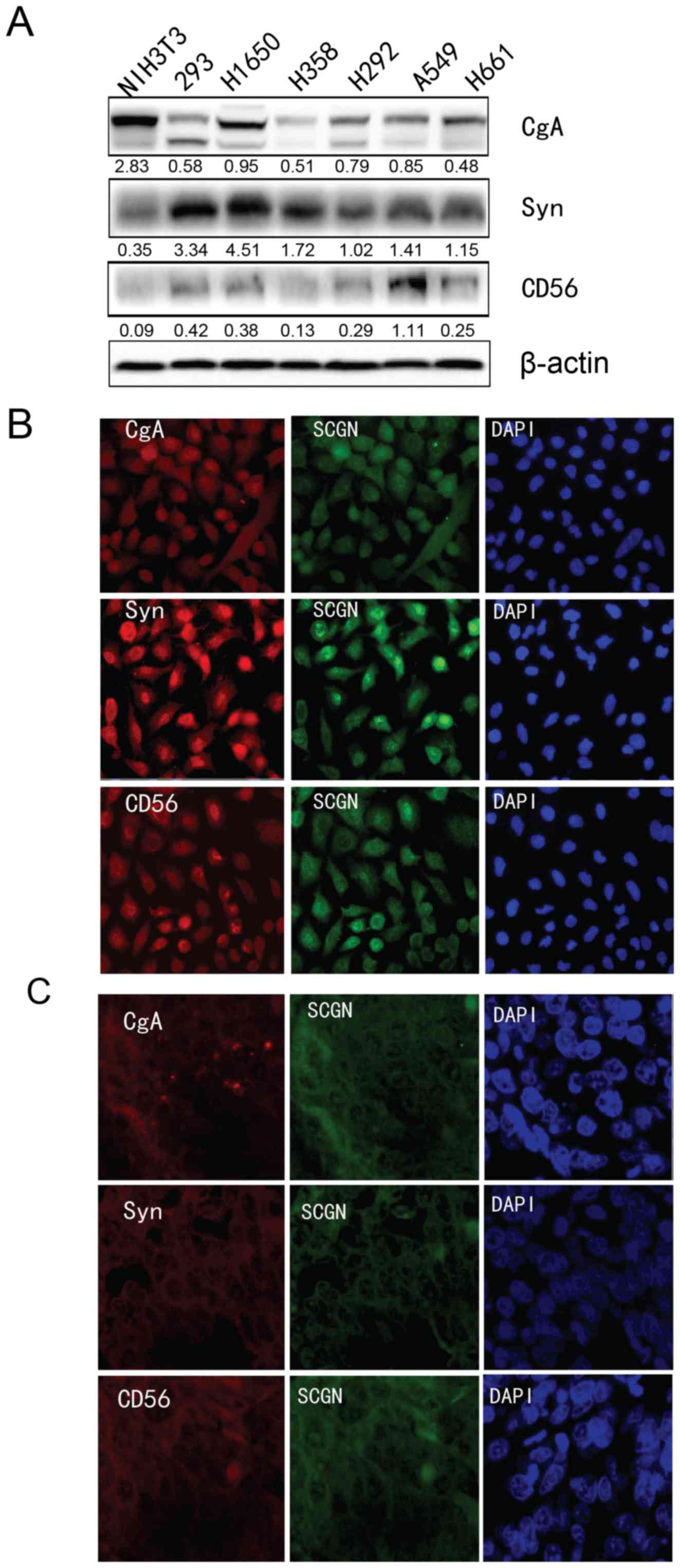|
1
|
Molina JR, Yang P, Cassivi SD, Schild SE
and Adjei AA: Non-small cell lung cancer: Epidemiology, risk
factors, treatment, and survivorship. Mayo Clin Proc. 83:584–594.
2008. View
Article : Google Scholar : PubMed/NCBI
|
|
2
|
Chen W, Zheng R, Baade PD, Zhang S, Zeng
H, Bray F, Jemal A, Yu XQ and He J: Cancer statistics in China,
2015. CA Cancer J Clin. 66:115–132. 2016. View Article : Google Scholar : PubMed/NCBI
|
|
3
|
Zhang C, Min L, Zhang L, Ma Y, Yang Y and
Shou C: Combined analysis identifies six genes correlated with
augmented malignancy from non-small cell to small cell lung cancer.
Tumour Biol. 37:2193–2207. 2016. View Article : Google Scholar : PubMed/NCBI
|
|
4
|
Pelosi G, Barbareschi M, Cavazza A,
Graziano P, Rossi G and Papotti M: Large cell carcinoma of the
lung: A tumor in search of an author. A clinically oriented
critical reappraisal. Lung Cancer. 87:226–231. 2015. View Article : Google Scholar : PubMed/NCBI
|
|
5
|
Zheng M: Classification and pathology of
lung cancer. Surg Oncol Clin N Am. 25:447–468. 2016. View Article : Google Scholar : PubMed/NCBI
|
|
6
|
Rusch VW, Klimstra DS and Venkatraman ES:
Molecular markers help characterize neuroendocrine lung tumors. Ann
Thorac Surg. 62:798–810. 1996. View Article : Google Scholar : PubMed/NCBI
|
|
7
|
Hamilton G and Rath B: Smoking,
inflammation and small cell lung cancer: Recent developments. Wien
Med Wochenschr. 165:379–386. 2015. View Article : Google Scholar : PubMed/NCBI
|
|
8
|
Yamazaki S, Sekine I, Matsuno Y, Takei H,
Yamamoto N, Kunitoh H, Ohe Y, Tamura T, Kodama T, Asamura H, et al:
Clinical responses of large cell neuroendocrine carcinoma of the
lung to cisplatin-based chemotherapy. Lung Cancer. 49:217–223.
2005. View Article : Google Scholar : PubMed/NCBI
|
|
9
|
Liang R, Chen TX, Wang ZQ, Jin KW, Zhang
LY, Yan QN, Zhang HH and Wang WP: A retrospective analysis of the
clinicopathological characteristics of large cell carcinoma of the
lung. Exp Ther Med. 9:197–202. 2015. View Article : Google Scholar : PubMed/NCBI
|
|
10
|
Lai M, Lu B, Xing X, Xu E, Ren G and Huang
Q: Secretagogin, a novel neuroendocrine marker, has a distinct
expression pattern from chromogranin A. Virchows Arch. 449:402–409.
2006. View Article : Google Scholar : PubMed/NCBI
|
|
11
|
Birkenkamp-Demtroder K, Wagner L, Brandt
Sorensen F, Bording Astrup L, Gartner W, Scherubl H, Heine B,
Christiansen P and Ørntoft TF: Secretagogin is a novel marker for
neuroendocrine differentiation. Neuroendocrinol. 82:121–138. 2005.
View Article : Google Scholar
|
|
12
|
Sharma AK, Khandelwal R, Sharma Y and
Rajanikanth V: Secretagogin, a hexa EF-hand calcium-binding
protein: High level bacterial overexpression, one-step purification
and properties. Protein Expr Purif. 109:113–119. 2015. View Article : Google Scholar : PubMed/NCBI
|
|
13
|
Li Y, Li Y, Liu J, Fan Y, Li X, Dong M,
Liu H and Chen J: Expression levels of microRNA-145 and
microRNA-10b are associated with metastasis in non-small cell lung
cancer. Cancer Biol Ther. 17:272–279. 2016. View Article : Google Scholar : PubMed/NCBI
|
|
14
|
Mountain CF: Revisions in the
international system for staging lung cancer. Chest. 111:1710–1717.
1997. View Article : Google Scholar : PubMed/NCBI
|
|
15
|
Blumenthal RD, Leon E, Hansen HJ and
Goldenberg DM: Expression patterns of CEACAM5 and CEACAM6 in
primary and metastatic cancers. BMC Cancer. 7:22007. View Article : Google Scholar : PubMed/NCBI
|
|
16
|
Li Y, Zhang H, Gong H, Yuan Y, Li Y, Wang
C, Li W, Zhang Z, Liu M, Liu H and Chen J: miR-182 suppresses
invadopodia formation and metastasis in non-small cell lung cancer
by targeting cortactin gene. J Exp Clin Cancer Res. 37:1412018.
View Article : Google Scholar : PubMed/NCBI
|
|
17
|
Alpár A, Attems J, Mulder J, Hökfelt T and
Harkany T: The renaissance of Ca2+-binding proteins in the nervous
system: Secretagogin takes center stage. Cell Signal. 24:378–387.
2012. View Article : Google Scholar : PubMed/NCBI
|
|
18
|
Ilhan A, Neziri D, Maj M, Mazal PR, Susani
M, Base W, Gartner W and Wagner L: Expression of secretagogin in
clear-cell renal cell carcinomas is associated with a high
metastasis rate. Hum Pathol. 42:641–648. 2011. View Article : Google Scholar : PubMed/NCBI
|
|
19
|
Attems J, Preusser M, Grosinger-Quass M,
Wagner L, Lintner F and Jellinger K: Calcium-binding protein
secretagogin-expressing neurones in the human hippocampus are
largely resistant to neurodegeneration in Alzheimer's disease.
Neuropathol Appl Neurobiol. 34:23–32. 2008.PubMed/NCBI
|
|
20
|
Maj M, Gartner W, Ilhan A, Neziri D,
Attems J and Wagner L: Expression of TAU in insulin-secreting cells
and its interaction with the calcium-binding protein secretagogin.
J Endocrinol. 205:25–36. 2010. View Article : Google Scholar : PubMed/NCBI
|
|
21
|
Wang YH, Yang QC, Lin Y, Xue L, Chen MH
and Chen J: Chromogranin A as a marker for diagnosis, treatment and
survival in patients with gastroenteropancreatic neuroendocrine
neoplasm. Medicine (Baltimore). 93:e2472014. View Article : Google Scholar : PubMed/NCBI
|
|
22
|
Takeuchi T, Minami Y, Iijima T, Kameya T,
Asamura H and Noguchi M: Characteristics of loss of heterozygosity
in large cell neuroendocrine carcinomas of the lung and small cell
lung carcinomas. Pathol Int. 56:434–439. 2006. View Article : Google Scholar : PubMed/NCBI
|
|
23
|
Wiedenmann B, Franke WW, Kuhn C, Moll R
and Gould VE: Synaptophysin: A marker protein for neuroendocrine
cells and neoplasms. Proc Natl Acad Sci USA. 83:3500–3504. 1986.
View Article : Google Scholar : PubMed/NCBI
|
|
24
|
Farinola MA, Weir EG and Ali SZ: CD56
expression of neuroendocrine neoplasms on immunophenotyping by flow
cytometry: A novel diagnostic approach to fine-needle aspiration
biopsy. Cancer. 99:240–246. 2003. View Article : Google Scholar : PubMed/NCBI
|
|
25
|
Turner BM, Cagle PT, Sainz IM, Fukuoka J,
Shen SS and Jagirdar J: Napsin A, a new marker for lung
adenocarcinoma, is complementary and more sensitive and specific
than thyroid transcription factor 1 in the differential diagnosis
of primary pulmonary carcinoma: Evaluation of 1674 cases by tissue
microarray. Arch Pathol Lab Med. 136:163–171. 2012. View Article : Google Scholar : PubMed/NCBI
|
|
26
|
Loy TS, Darkow GV and Quesenberry JT:
Immunostaining in the diagnosis of pulmonary neuroendocrine
carcinomas. An immunohistochemical study with ultrastructural
correlations. Am J Surg Pathol. 19:173–182. 1995. View Article : Google Scholar : PubMed/NCBI
|

















